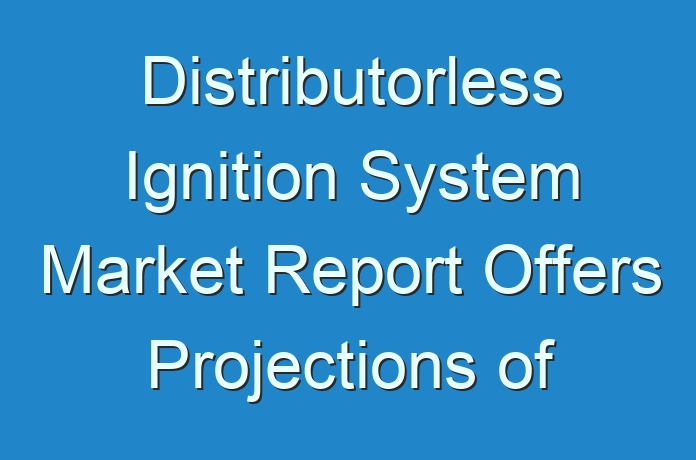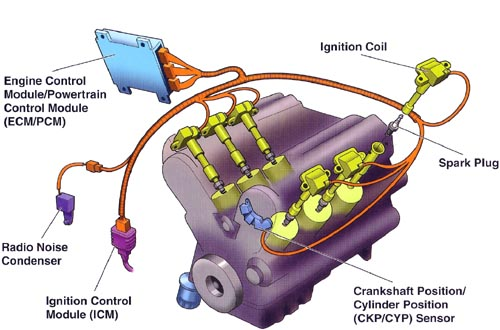
Distributorless Ignition System: Introduction
- The electronic ignition system is used in almost all the latest super and hyper series cars and bikes; however, this system has a few limitations. The electronic ignition system uses a distributor, a mechanical device that contains a rotor which completes the circuit and also controls the spark timing. This makes this system less efficient, requires higher maintenance, and periodic check for the distributors’ point gap as they subjected to wear and tear. Consequently, automakers have been employing distributorless ignition system for the last few years in order to overcome these limitations.
- In the distributorless ignition system, the distributor of the electronic ignition system is replaced with several induction coils, i.e. one coil per cylinder or one coil for pair of cylinders, and the timing of the spark is controlled by an ignition control unit and the engine control unit. Usage of multiple ignition coils provides direct voltage to the spark plugs, which makes this system more efficient and accurate.
Key Drivers of Global Distributorless Ignition System Market:
- The spark timing accuracy of the electronic ignition system decreases with time. This issue prompted the development of a distributorless ignition system in which the spark time accuracy is increased by using electronic control unit along with ignition module. Moreover, the distribution of voltage signal to the spark plugs is made direct using multiple ignition coils, which further decreases the wear and tear of the system and makes the system more efficient and reliable. This is likely to drive the demand for distributorless ignition system across the globe.
- Increase in prices of fuel coupled with rise in environment concerns regarding fuel emissions from automobiles is compelling key players in the automotive industry to manufacture efficient ignition system such as distributorless ignition system. A few key players are investing on the development of such a system, which in turn is likely to propel the distributorless ignition system across the globe.
Planning to lay down future strategy? Perfect your plan with our report sample here https://www.transparencymarketresearch.com/sample/sample.php?flag=S&rep_id=82040

Distributorless Ignition System Market to Offer Attractive Opportunities:
- Low initial and maintance cost of distributor ignition system as compared to other type of ignition systems, makes it more preferable for automakers for integration in their vehicles. This is likely to boost the distributorless ignition system market across the globe.
- Demand for distributorless ignition system is expected to increase in the passenger car segment due to environmental concerns and stringent emission norms. This is estimated to offer significant opportunity for the distributorless ignition system market across the globe.
Rise in Electric Vehicle to Hamper Market:
- The automotive industry is experiencing a shift from conventional engines to electric vehicles to reduce carbon footprints. Advancements in electric vehicles has enhanced the driving range, efficiency, and power of the vehicle. Electric vehicles work on totally different principle and do not require an ignition system.
- Rise in demand for electric vehicles from consumers and high investment by automakers on the production of electric vehicles are key factors that are likely to hamper the distributorless ignition system market across the globe
Asia Pacific Distributorless Ignition System Market to Expand Rapidly:
- Asia Pacific is the most populous region. The urban population across Asia Pacific is increasing consistently, which can be attributed to employment opportunities and increased standards of living in urban areas.
- This market in the region is projected to expand at a rapid pace, as the region comprises rapidly developing economies, such as China and India. The market in Asia Pacific is primarily driven by China, where the rate of adoption of distributorless ignition system is increasing, owing to its durability, fuel economy, and emission reduction. This, in turn, is driving the distributorless ignition system market in the region.
Key Players Operating in Global Market
The global distributorless ignition system market is highly fragmented with top manufacturers across the globe. Some of the key players operating in the global distributorless ignition system market are:
- Robert Bosch GmbH
- Hitachi Automotive Systems Americas, Inc.
- Denso Corporation
- Diamond Electric Mfg. Co., Ltd.
- Hella GmbH & Co.
- BorgWarner Inc.
- Walker Products, Inc.
- MARSHALL ELECTRIC, CORP
- ACDelco
- Mitsubishi Electric Corporation
- NGK SPARK PLUG’s GROUP
- Valeo
- YURA TECH.
Looking for exclusive market insights from business experts? Buy Now Report here https://www.transparencymarketresearch.com/checkout.php?rep_id=82040<ype=S
Global Distributorless Ignition System Market: Research Scope
Global Distributorless Ignition System Market, by Engine Type
- Gasoline
- Diesel
Global Distributorless Ignition System Market, by Vehicle Type
- Passenger Vehicle
- Hatchback
- Sedan
- Utility Vehicle
- Light Commercial Vehicle
- Heavy Commercial Vehicle
Global Distributorless Ignition System Market, by Sales Channel
- OEM
- Aftermarket
Global Distributorless Ignition System Market, by Region
- North America
- U.S.
- Canada
- Europe
- Germany
- France
- U.K.
- Italy
- Spain
- Russia & CIS
- Rest of Europe
- Asia Pacific
- China
- Japan
- India
- ASEAN
- Rest of Asia Pacific
- Latin America
- Brazil
- Mexico
- Rest of Latin America
- Middle East & Africa
- GCC
- South Africa
- Rest of Middle East & Africa
This study by TMR is all-encompassing framework of the dynamics of the market. It mainly comprises critical assessment of consumers’ or customers’ journeys, current and emerging avenues, and strategic framework to enable CXOs take effective decisions.





